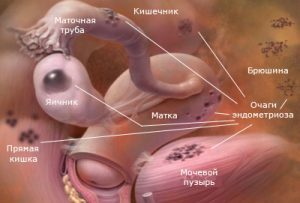With the diseases of the urinary system, about 80% of women in their lives have experienced( cystitis, for example, is known to most people firsthand).Endometriosis of the bladder, the symptoms and treatment of which should be known to every girl, is a rare, but insidious disease from the same sphere. The main feature is the emergence of segments of epithelial and stromal cells in various organs of the female body. The new formations correspond to the endometrium, so most changes in them depend on the phase of the menstrual cycle. At the site of localization, the disease can be in the genitals or be extragenital. It is to the latter group that the endometriosis of the bladder is included.
Causes of bladder endometriosis
 Urinarythe bladder is located in the small pelvis of a woman and plays a leading role in the process of excretion of urine from the body. Any violation of the function of this body adversely affects the life of a person. Since the bladder in women coexists with internal and external genital organs, it can be involved in pathological problems of the female sexual sphere.
Urinarythe bladder is located in the small pelvis of a woman and plays a leading role in the process of excretion of urine from the body. Any violation of the function of this body adversely affects the life of a person. Since the bladder in women coexists with internal and external genital organs, it can be involved in pathological problems of the female sexual sphere.
Endometrium is a mucous membrane of the uterus, whose cells under certain conditions can increase their growth and capture neighboring organs. The bladder is in the immediate vicinity of the uterus, and therefore, the extrogenital endometriosis affects it in the first place.
The most common disease occurs in women aged 18 to 45 years. Specialists attribute this age-specific pathology to the hormonal factor. Outside of these frames, endometriosis of the bladder can be detected in up to 5% of patients.
Another 20 to 30 years ago, the disease was diagnosed quite rarely, but given the general background of weakening the immune system and environmental degradation, the number of people with endometriosis of the bladder is growing rapidly.
By the degree of damage to surrounding tissues, the disease can be divided into several types:
- pathological tissue structures of a single character located on the surface of the walls of the bladder;
- one or more small foci with the germination of connective tissue into the depth of the wall of the bladder;
- formation of adhesions in the lumen of the bladder;
- affects 100% of the bladder wall and a pronounced adhesion process.
Endometriosis of a bladder in a woman can occupy an area of several millimeters to 7-9 cm. Quite often, specialists mark the development of tumor formation in the lumen of the bladder in this pathology, because of which it decreases. In addition, the formation of scars leads to the development of adhesive process in the small pelvis.

Several medical theories of the occurrence of such a pathology are considered in the medical literature. The greatest number of adherents have three main causes of the development of endometriosis:
- implant theory;
- embryonic origin of endometriosis;
- metaplastic theory of the onset of bladder disease.
However, a large number of specialists in urology do not discount the hereditary origin of the disease, since in 20% of cases the endometriosis of the bladder is diagnosed at a fairly young age and with the complete absence of any manifestations from the female genital organs.
The main symptoms of bladder disease in women
There are several basic symptoms that are characteristic of any localization of the pathological process. First of all, doctors note a long and constantly progressing course of the disease. Relative regress of endometriosis of the bladder is possible only after the onset of of menopause, when female sex hormones cease to affect all organs and systems.
One of the main symptoms of the disease is pain. It usually appears or intensifies 2 to 3 days before menstruation and disappears after the end of menstruation. In severe course of endometriosis, pain syndrome can persist for a long time and can be coped with great difficulty.
A bladder with a similar pathology can increase in size, often putting pressure on the organs located next to it. The increase and decrease of the affected bladder can also be directly related to the woman's menstrual cycle.
For endometriosis, the symptoms of the urinary system are also quite typical:
- blood in the urine or turbid urine mixed with flakes;
- marked pain in the pelvic region, which can be permanent or occur only when urinating;
- nocturnal or chronic urinary incontinence;
- occurrence of swelling of the face, trunk and lower limbs.

Methods for diagnosis of bladder endometriosis
If such symptoms occur, a woman should seek professional advice. When diagnosing pathology, an important role is played by studying the patient's life history. First of all it is necessary to exclude hereditary character of the disease, possible traumas and the transferred diseases. It is also important to pay attention to the problems of the sexual sphere of the patient.
Of great importance is:
- state of the reproductive system in women;
- duration and frequency of menstruation;
- presence of inflammatory diseases of the genital organs;
- number of births, abortions;
- transferred gynecological operations.
Conducting laboratory diagnosis will determine the presence of bleeding and inflammation in the urinary bladder, and a general urine test will give a comparative characteristic of the state of the urinary system as a whole.
From the instrumental methods of diagnosis of endometriosis of the bladder, the most common was the conduct of cystoscopy. This procedure is carried out using a cystoscope, which through the urethra is inserted into the bladder of a woman, allows you to determine the nature and extent of its damage. The very manipulation is painful enough, therefore it is carried out under general anesthesia in a hospital.
If you can not make a clear differential diagnosis of endometriosis with other bladder lesions, you can use ultrasound and magnetic resonance imaging.
Treatment of bladder pathology
Treatment of the disease should be comprehensive, differentiated and consider the following factors:
- the age of the patient;
- psychological personality characteristics and the patient's attitude to possible pregnancies in the future;
- localization of the pathological process, its prevalence and severity of the course;
- presence of an inflammatory component, various adhesions of endometriosis;
- hyperplastic processes in the endometrium and the threat of malignancy.
Bladder endometriosis can be treated conservatively and operatively. At the end of the main therapy, the patient is shown a rehabilitation period aimed at eliminating residual disorders, restoring work capacity and other types of social activity.
Operative treatment of endometriosis
Surgical treatment of this disease consists in resection of the bladder. Usually surgeons remove the affected part, excising endometriosis foci to a healthy tissue. This helps to avoid relapse of the disease.

Medications for the treatment of illness in women
In conservative therapy of endometriosis of the bladder, the main role is assigned to the use of progestins. Preparations "Linestrenol" and "Norkolut" were widely used in the late 80's and have not lost their relevance today.
Foreign sources offer a synthetic preparation "Danazol" for the treatment of endometriosis. This medicine is used 400-800 mg per day for 6 months, and in severe cases, therapy can last up to a year. A good drug for the treatment of bladder endometriosis is "Gestrinone".Possessing high biological activity, this drug has a pronounced therapeutic effect even in small doses.
Many authors note a rather high effect from the use of these drugs. Relapse of the disease was no more than 18%, however, in a significant number of cases it is possible to speak only about remission of bladder endometriosis.
Good results are obtained by the use of reflexotherapy and the use of medicinal leeches in the treatment of this severe disease. Different types of physiotherapy combined with sanatorium treatment can also enhance the effect of the recovery period.
Any disease is easier to prevent than cure. This well-known truth is fully applicable to bladder endometriosis. Women are advised to carry out a preventive examination twice a year from a gynecologist and an endocrinologist, and not to delay treatment with hormonal and other disorders. These patients will be able to improve their quality of life and avoid major problems with their health in the future.

 We recommend reading the article about preparations for the treatment of endometriosis in women. From it you will learn about the features of the disease, the purposes of drug therapy, the drugs used.
We recommend reading the article about preparations for the treatment of endometriosis in women. From it you will learn about the features of the disease, the purposes of drug therapy, the drugs used.